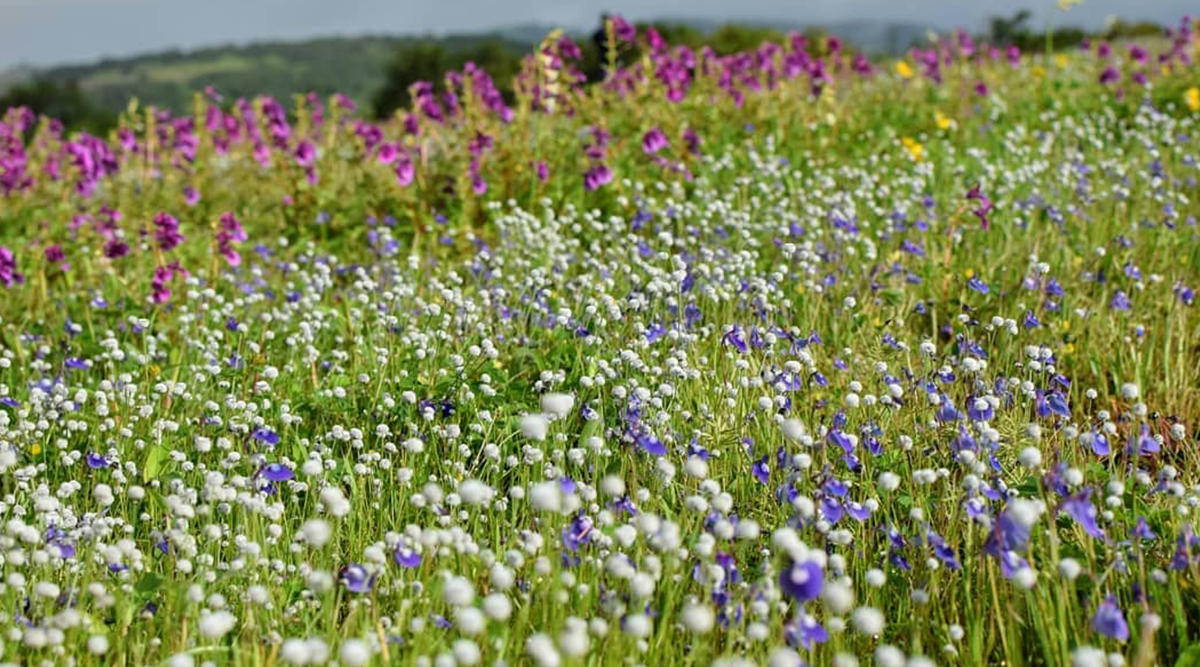Agharkar Research Institute of in Pune, Maharashtra has conducted a study in which it has revealed significant climate and environmental changes on the Kaas Plateau. The Kaas Plateau, a UNESCO World Heritage Site (2012), is renowned for its seasonal flowers that form a vibrant carpet during August and September.
Location of Kaas Plateau
Kaas Plateau is located in the Satara district consists of several varieties of flowers that bloom at a particular season of the year. Kaas Plateau is at a distance of 25 KM from the city of Satara.
Geographical features:
- Kaas Plateau is a part of the Western Ghats Range.
- It is made of igneous rock.
- Unlike other plateaus or tablelands in this region, Kaas Plateau has a relatively thinner layer of soil.
Weather conditions of the Kaas Plateau:
The region is located at an altitude of 1200 meters. It spreads over an area of about 1000 hectares (10 sq. kilometers).
Extreme weather can be observed on the plateau around the year. The average temperature usually varies between 19 and 30 degree Celsius. However, between April and May the temperature climbs up to 44 degree Celsius. At night, in winter times, it can go as low as 10 degree Celsius.
In terms of rainfall the plateau receives around 736 mm of rain each year.
Unique Features of the Kaas Plateau:
Kaas Plateau is a plateau made from volcanic rocks in the Satara district of Maharashtra. It falls in the biosphere of the Western Ghats.
The flowers, for which the plateau is known, blooms after the July rains. With a variety of different flowering plants, several species of insects especially butterflies are seen in abundance.
Kaas Plateau is declared a UNESCO World Heritage Site in 2012.
The government has taken several steps to control the possible damage by tourists, a limit of a maximum of 3000 visitors per day has been laid.
In the month of September, some of the most common flowering plants that we can see are Eriocaulon Manoharani, Pogostemon deccanensis, Senecio graham, Impatiens oppositifolia and Dipcadi montanum etc.
The Kaas plateau experiences a natural cycle of extreme conditions. It becomes wet water-logged cool in monsoon rains, very dry at hot summer (45 degress Celsius) and dry winter (5 degree Celsius).
The soil found in the Kaas Plateau is a thin layer on top of Deccan rock, with varying quality of nutrients.
Biodiversity of Kaas Plateau:
Kaas Plateau has a rich biodiversity. Over 850 species of flowering plants grow in the plateau, including Karvy, Orchids, Smithia Hirsute (Mickey Mouse Flower) and many more. Out of them 39 are exclusive to this region and 33 are listed as endangered by the International Union for Conservation of Nature.
Insectivorous Flowers are also grow on the plateau such as the Utricularia, Purpurascens and the Drosero.
During the month of August and September, the Kaas Plateau takes up a fantastic visage and swathes with white blooms of vibrant shades.
Most of the plant species found on the plateau found rare and new to the botanical science making it an important research site.
Kaas Plateau is home to 1500 plant species, 450 wildflower species out of which 33 are endangered.
Visiting rules and Time:
- The best time to visit the Kaas Plateau is from late August to early October.
- This plateau is open for visitors from 8:00 A.M. till 6:00 P.M.
- Online booking is mandatory to visit the plateau.



 Indian Olympic Medal Winners List Till N...
Indian Olympic Medal Winners List Till N...
 Who is the Inventor of the Gramophone?
Who is the Inventor of the Gramophone?
 HS Dhaliwal Appointed New DGP Of Andaman...
HS Dhaliwal Appointed New DGP Of Andaman...
